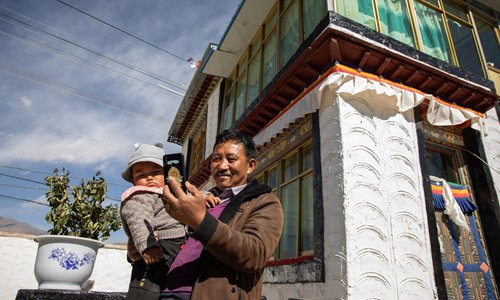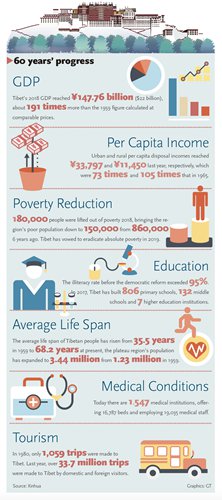By Li Ruohan and Deng Xiaoci

A senior official from Southwest China’s Tibet Autonomous Region said the human rights situation in the region is “very good” and Tibet is enjoying one of its best periods in history as people’s aspirations for a stable society are stronger than ever.
The remarks were made by Norbu Dondrup, vice chairman of the Tibet regional government, at a press conference on Wednesday announcing the release of a white paper on Tibet, titled Democratic Reform in Tibet – Sixty Years On.
The region’s vice chairman also blasted outsiders’ criticism of the region’s adherence to human rights. Some countries have been fooled and bewitched by the Dalai clique that continues to criticize the human rights situation in Tibet, said Norbu Dondrup.
It is the more than 3 million people living in Tibet who have the biggest say in the human rights situation in the region and people’s satisfaction and happiness are the best measure of human rights, said the official.
“Before 1959, the one million serfs in Tibet had no idea of human rights. They didn’t have any awareness of human rights as their rights had been deprived of under feudal serfdom. They didn’t have the rights to life, let alone the rights to develop,” said Norbu Dondrup.
The official said the old society before 1959 was “very dark and very cruel” as serfs were traded, slaughtered, imprisoned and even skinned at will. He said the Dalai Lama is in no position to talk about human rights in the region and his attacks have “ulterior motives.”
By abolishing serfdom, a grim and backward feudal system, Tibet was able to establish a new social system that liberated the people and made them masters of the nation and society, thus ensuring their rights in all matters, said the white paper.

The year 2019 marks the 60th anniversary of democratic reform in Tibet. The white paper released Wednesday was the 14th such document released by China’s State Council Information Office.
Since 2013, some 710,000 people have been lifted out of poverty in Tibet. The region’s poverty rate has dropped from 35.2 percent in 2012 to less than 6 percent in 2018, the white paper said.
Tibet’s human rights and advances in other fields have seen “unprecedented and remarkable” progress since the democratic reform in 1959, Norbu Dondrup said at the press conference.
When asked whether a referendum could be held in Tibet, the official said the so-called “Tibet independence” issue was cooked up by the imperialists in the past.
“Tibet is an inalienable part of China. We have never recognized ‘Tibet independence,’ neither has any other country,” he said.
While denouncing the idea of holding a referendum in Tibet as nonsense, Penpa Lhamo, deputy head of the Contemporary Studies Institute at the Tibet Academy of Social Sciences, said people in Tibet have sufficient channels to express their opinion and be engaged in social governance.
Since 1978, Tibet has held 11 elections for deputies to the people’s congresses at the township level, 10 at the county level, and eight at the level of municipalities that have subordinate districts, according to the document.
There are 35,963 deputies to the people’s congresses at all levels in Tibet. Tibetans and other ethnic minority groups account for 92.18 percent of the deputies, it said.
At the Wednesday news conference, officials also noted religious freedom is sufficiently safeguarded in the region while noting that believers should not be fooled by separatists.
“It’s clearly written in Chinese law that every citizen has the right to religious freedom. However, those who stir up religious fervor to serve a separatist agenda and violate the law should be punished in accordance with the law. This is same as in all other countries,” said Norbu Dondrup.
In a society ruled by feudal serfdom under theocracy, religious freedom is just a fallacy as the religion in power would damage and oppress believers of other faiths, said Penpa Lhamo.
The democratic reform brought institutional and legal guarantees for religious freedom in Tibet. Central and local governments also offered sufficient policies and funding to protect religious culture and relics in the region, she said.
Wang Xiaobin, a scholar at the Beijing-based China Tibetology Research Center, told the Global Times that Tibetan Buddhism was “tarnished” before the democratic reform in Tibet as the religion was used as a political tool to oppress the people and interfere with administrative and judicial affairs.
After the democratic reform in 1959, Tibetan Buddhism was back on the track of a religion to serve believers instead of being a political tool, said Wang, noting that the reform has “liberated” Tibetan Buddhism and given a new life to the religion.
There are 1,787 religious venues in Tibet, accommodating some 46,000 monks and nuns, and 358 living Buddhas.
The region also has four mosques, and some 12,000 Muslims, as well as a Catholic church with more than 700 followers, said the white paper.
All the monks and nuns registered in the autonomous region enjoy the benefits of the social security net, with full medical insurance, old-age benefits, subsistence allowance, and personal accident insurance, the white paper added.
Never separated
Facing issues of reincarnation and power transition in the post-Dalai era, the Dalai clique felt a strong sense of crisis and anxiety and they may step up separatist actions or resort to violent actions to shift internal conflicts, said Wang.
Risks also come from international society. The US will not stop using Tibet-related affairs to pressure China and gain more bargaining chips for negotiations on other issues, said Wang.
Tibet-related affairs have been frequently picked up by the US to challenge China after President Donald Trump signed into law a Reciprocal Access to Tibet Act in late 2018.
China on Tuesday expressed firm opposition to the act after the US on Monday claimed that China “systematically” impedes Tibet access.
“Since the democratic reform 60 years ago, the destiny and development of Tibet are in the hands of the Chinese people, including those in Tibet, and there’s no need for the US to bother worrying about the region’s future,” Zhu Weiqun, former head of the Ethnic and Religious Affairs Committee of the National Committee of the Chinese People’s Political Consultative Conference, told the Global Times.
Those US tricks to pressure China and smear the image of the region will not work as long as the region continues to develop and the progress is introduced to international society, said analysts.
US support to the Dalai clique can only bring disaster to the region and is a road that leads to nowhere, said Zhu. A more practical approach for the US would be separating itself from the clique that is facing a dead end, he said.
Though facing a fading influence, separatists will not stop their activities. Apart from efforts to promote development and stability in Tibet, China should also strengthen ideological-related work in the region, said Penpa Lhamo.
The development of Tibet, which accounts for nearly one-sixth of China’s territory, is an important cause for China. Tibet’s progress will also help the country’s mission to lift those living close to the region, such as those in Qinghai and Sichuan out of poverty, said Zhu.
A rising star
To get a glimpse of the contrast in development between China’s Tibet Autonomous Region and other Himalayan regions, as well as their interactions, Global Times reporters visited neighboring regions in India and Nepal earlier this month.
A Chinese worker who was involved in an infrastructure project two years ago in the pastures of Tibet shared with the Global Times a rare encounter with Nepali farmers.
“Despite his inability to speak Chinese, the Nepali farmer family showed their goodwill toward China by giving a thumb-up gesture when they knew that I am Chinese,” said the worker.
“They treated us with food and drinks,” said the worker who preferred to stay anonymous.
On the Nepali side of the Rasog Bridge linking China and Nepal, Chinese workers are helping Nepal build a bridge that had shown several cracks after the Nepal earthquake in 2015.
More and more people from Nepal are attracted to the town of Gyirong where they can earn more compared to their hometowns.

A young waitress from Nepal who’s been working at a Nepali food restaurant said she can earn around 2,000 yuan a month in Gyirong without the need for food and accommodation expenditures. The salary is nearly double that of her hometown, she told the Global Times.
The development of Tibet was similar to Nepal about 20 years ago when people were very poor and their life was difficult, but now it’s 100 percent different as the Tibetan people are becoming more prosperous, thanks to the growth of China’s economy, Prem Sagar Poudel, president of the Nepal-China Mutual Cooperation Society, told the Global Times.
With the further implementation of the Belt and RoadInitiative, Tibet’s economic ambition is spreading to South Asia, where more opportunities are being created, said analysts.
Nepal can obtain growth opportunities and development experience through business cooperation with people in Tibet’s border towns, as demonstrated by the fact that more Chinese vendors are doing business in Kathmandu, Nepal’s capital, Poudel said.
Since ancient times, Tibet has been well connected with other Himalayan regions and the cultural, trade, tourism and people-to-people interactions will significantly increase as the Belt and Road Initiative moves forward, Penpa Lhamo said.
If the border regions in India and Nepal could seize the opportunity of China’s policies of developing Tibet, the regions, which have had close interaction with Tibet in history, would enjoy vast opportunities in the future, Zhu said.
Huang Ge and Zhang Hongpei contributed to this story
Source:Global Times

